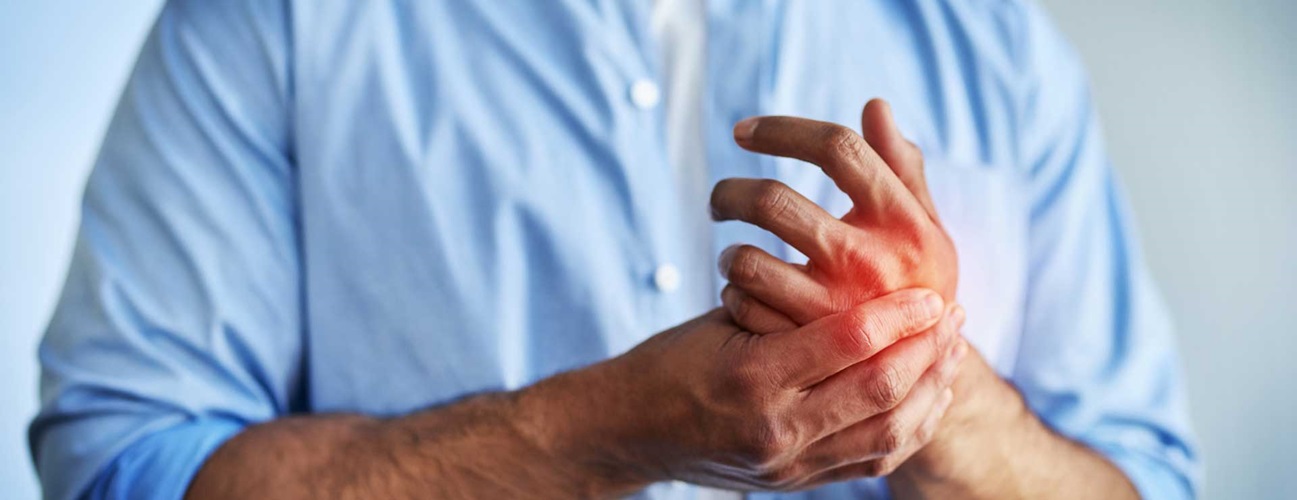Ulnar Nerve Entrapment
The ulnar nerve branches off the brachial plexus nerve system and travels down the back and inside of the arm to the hand. The ulnar nerve transmits electrical signals to muscles in the forearm and hand. The ulnar nerve is also responsible for sensation in the fourth and fifth fingers (ring and little fingers) of the hand, part of the palm and the underside of the forearm.
Ulnar nerve entrapment can cause pain, numbness and tingling in the forearm and the fourth and fifth fingers. In severe cases, ulnar nerve entrapment can cause weakness in the hand and loss of muscle mass.
What You Need to Know
- The condition occurs when the ulnar nerve becomes compressed as it passes through the wrist or elbow.
-
Ulnar nerve entrapment is also known as:
- Bicycler’s neuropathy or handlebar palsy
- Guyon’s canal syndrome
- Tardy ulnar palsy
- Cubital tunnel syndrome
- It can be treated non-operatively with occupational therapy, medications and splints. In severe cases, the doctor may recommend surgery.
Ulnar Nerve Entrapment Symptoms
Symptoms of ulnar nerve neuropathy may include:
-
Weakness or tenderness in the hand
-
Tingling in the palm and fourth and fifth fingers
-
Sensitivity to cold
-
Tenderness in the elbow joint
Ulnar Nerve Entrapment Diagnosis
After a detailed history and physical exam, your doctor may order additional tests, including electromyography (EMG) and nerve conduction study (NCS), to evaluate how the muscles and nerves are functioning. An EMG measures ongoing muscle activity and response of the muscle to its nerve stimulation. An NCS measures the amount and speed of conduction of an electrical impulse through a nerve.
The doctor may also order any of the following imaging techniques:
-
MR neurography - an MRI that uses specific settings or sequences that produce enhanced images of nerves. From the patient’s perspective, the experience is the same as undergoing a regular MRI.
What causes ulnar nerve problems?
Ulnar nerve entrapment at the elbow can occur when there is prolonged stretching of the nerve by keeping the elbow fully bent or when there is direct pressure on the nerve from leaning the elbow against a solid surface. Entrapment at the wrist can occur when there is direct pressure on the nerve by leaning on handlebars during long bike rides or prolonged use of hand tools. Similar to the phenomenon of a person’s arm “going to sleep,” or “hitting your funny bone,” a pinched ulnar nerve can result in tingling, pain and numbness.
In some people, the ulnar nerve does not stay in its proper position and can shift across a bump of bone in the elbow when the arm flexes, referred to as a subluxing nerve. Repeated shifting can cause irritation of the ulnar nerve.
Ulnar Nerve Entrapment Treatment
Nonsurgical Treatment for Ulnar Nerve Entrapment
Depending on the severity of a person’s ulnar nerve entrapment, the physician may recommend the following:
-
Occupational therapy to strengthen the ligaments and tendons in the hands and elbows
-
Drugs such as aspirin, ibuprofen and other nonprescription pain relievers to help reduce pain and inflammation
-
Splints to help immobilize the elbow
Surgery for Ulnar Nerve Entrapment
When physical therapy and other forms of nonoperative treatment fail to control pain and restore function, nerve release surgery may be the best option to address symptoms. There are two types of ulnar nerve release surgery:
-
At the elbow. The surgeon makes an incision at the patient’s elbow and performs a nerve decompression, and in some instances, moves the nerve to the inner part of the arm so that it is in a more direct position.
-
At the wrist. If the compression is at the wrist, the surgeon makes the incision there to access the ulnar nerve and performs the decompression at that location.
Recovery from Ulnar Nerve Entrapment Surgery
Most people can get their bandages removed within 24 hours and stitches are taken out in about 10 days. Return to full activity may take four to six weeks.



